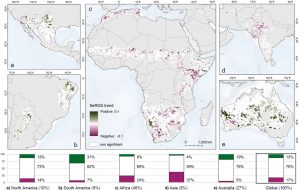Better late, than never.
In August 2020, I was so lucky to get a centerpiece of my dissertation (entitled Global Dryland Vegetation: Extent, functioning and drivers of change), which I defended in May the same year, published in Nature Sustainability. The article is concerned with questions about where and why vegetation productivity changes in relation to available rainfall in global dryland areas.
Find the full online article here or ask me for a pdf version: https://www.nature.com/articles/s41893-020-00597-z.
More than 40% of the land on Earth is composed of regions where rainfall and natural resources are naturally limited. These are called drylands and comprise vast areas that support around 30% of the world’s population – 90% of whom live in developing countries. More than half of all birds and mammals on Earth live in drylands and they play an important role in global food production. In the wake of global climate change, drylands are projected to expand by up to 23% by the end of the 21st century. At the same time, rising global temperatures and increased frequency of hazards such as droughts, floods and fires in combination with a rapidly growing population will likely increase pressure on these vulnerable ecosystems due to increased demand for natural resources and ecosystem services.
It is thus important to understand how, and especially why, drylands are changing over time and develop methods to identify and mitigate potential negative changes in ecosystem functioning.
One key aspect of every ecosystem is the living organisms it contains. As such, vegetation such as trees, shrubs and grasses are important as they absorb carbon dioxide from the atmosphere. They are also important for the well-being of humans because people depend on products derived from plants for food, forage, feed, and fuel. In drylands, where vegetation productivity is tightly linked to the availability of water, the sensitivity of vegetation to rainfall is one major factor of vegetation functioning – which is the main subject of my research.
For this study, colleagues from IGN, Lund, Wageningen and Bergen University and I, used satellite imagery of vegetation and rainfall from 2000 to 2015 to analyze the development of vegetation functioning in global drylands. Additionally, we were interested in linking potential drivers to the changes that we found.
These are the key findings of the study in a nutshell:
- One-third of the global dryland area has shown significant trends in vegetation functioning, of which 13% were positive and 17% were negative between 2000 and 2015.
- Population was the main driver of negative changes, especially for developing countries.
- Positive changes in vegetation functioning were predominantly seen in richer countries, likely profiting from favorable climatic conditions and/or caused by an intensification and expansion of human land management.
- We highlight geographic and economic differences in the relationship between vegetation functioning and associated drivers in tropical drylands.

Details about the proposed methods and assessments are available from the article or via e-mail at christin.abel@ign.ku.dk.
